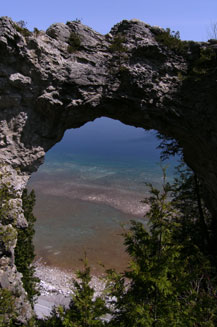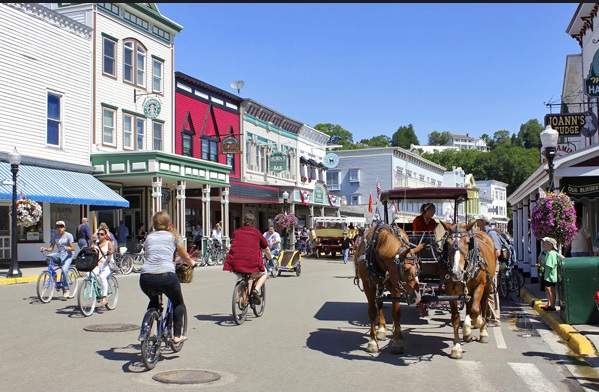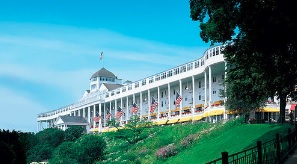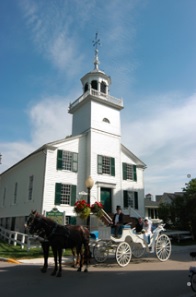VISIT MACKINAC ISLAND
Ferry Service From St. Ignace To Mackinac Island
When you plan your St. Ignace Mackinac Getaway, be sure to include a trip to Mackinac Island. St. Ignace offers two Ferry lines that service the island daily, from docks conveniently located in the downtown area. Just climb aboard and enjoy a relaxing scenic cruise, across the Straits of Mackinac.
A Rich History
Mackinac Island’s name is rooted in its Native history and culture. The Anishinaabe, who likened the shape of the island to the shell of a turtle, named it mishi-mikinaak meaning “big turtle”. The French pronounced it Michilimackinac and the British shortened this to the current name, Mackinac.
The entire Island – some 3.8 square miles – is a resort area. Originally home to an Ojibwa settlement, contact with first French and then British explorers and fur traders changed the face of the Island. The strategic location of the Island led to the establishment of Fort Mackinac by the British in 1780. It came under American control in 1796.It was during the Victorian era that Mackinac Island became one of America’s preferred summer resorts. Vacationers traveled the Great Lakes by large excursion boats that set sail from Buffalo, Cleveland, Chicago and Detroit.
To accommodate overnight guests on the Island, boat and railroad companies built elaborate summer hotels such as the Grand Hotel. Many wealthy industrialists who visited the Island returned to build their own summer homes on the east and west bluffs. A rich social life evolved that featured tennis, hiking, bicycling as well as golf at the Wawashkamo Golf Course. The entire Island is listed as a National Historic Landmark as a result of the preservation and restoration of its eclectic architecture.


Welcome To Our Village
Visitors step off one of the ferries servicing the Island and into a world filled with the charm of a Victorian village but all the modern conveniences – except, of course, for motorized vehicles. The downtown streets are lined with many retail businesses as well as candy shops and restaurants. One of the most popular items is the locally-produced Mackinac Island Fudge. Visitors purchase it in such quantities that they are often referred to as “fudgies”.
Enjoy the hustle and bustle of a nineteenth century downtown area but take time to bask in the Island’s beautiful rustic interior and its peaceful lakefront perimeter path. Drink in the majesty of the Straits and the Great Lakes. Don’t forget to pick up a pebble to ensure that you will return to the Island again and again.
Annual Island Events
Mackinac Island is generally recognized as America’s premier natural theme park. With transportation limited to horse and buggy, bicycle or foot, it has maintained the slower pace of a by-gone time. Despite this, visitors to the Island have an opportunity to participate in any number of seasonal events.
The highlight of the Island’s calendar of events is Annual Lilac Festival, a ten-day festival that has been held each year since 1949. The festival features one of the largest “All Horse Hitch” parades in the world. The American Bus Association has designated Mackinac Island’s Lilac Festival as one of the nation’s top 100 tourist attractions.
Other annual events include a yacht race, a fudge festival, a music festival and even a stone-skipping competition. There is definitely something for everyone!

Sites of Interest
Mackinac Island was designated as a National Historic Landmark in October of 1960. Because of the island’s long history and the preservation efforts that started as early as 1890, eight separate locations on the island, and a ninth site on adjacent Round Island, are listed in the United States National Register of Historic Places. Sites well worth visiting include:



Fort Mackinac
The Fort was built in 1780 but decommissioned as a fort in 1895 when it no longer served a strategic purpose. It has been restored to its late 19th century state through efforts beginning in the 1930s.
Biddle House
This house is one of the oldest structures on Mackinac Island. It was built about 1780 and is an interpretive site, depicting its original role as the home of a prosperous family home during the height of the fur trade.
McGulpin House
This house represents a working-class home from the late eighteenth century. Constructed as early as 1780, the house depicts a frontier working-class home.
Mission House
This house was built in 1825 by Presbyterian missionary William Montague Ferry as a boarding school for Native American children. It became a hotel in 1849 and a rooming house in 1939. It now houses State Park employees.
Agency House
The Agency House was built in 1820 for Robert Stuart, the Agent for the American Fur Company. It is now open to the public as a fur trade museum.
Indian Dormitory
The Indian Dormitory was constructed under direction of U.S. Indian agent, Henry Rowe Schoolcraft in 1836 following the signing of the Treaty of Washington. It was intended to be a school as well as a place for Native Americans to stay when they traveled to the Island to collect the yearly allotments. The building was restored in 1966 and converted to a museum. Although the original museum closed in 2003, the building reopened in July of 2010, as the Richard and Jane Manoogian Mackinac Art Museum. It showcases Mackinac art from prehistory to the present.
Matthew Geary House
The Geary House, built in 1846, was added to the register in 1971. It is available for vacation rentals.
Wawashkamo Golf Course
Laid out in 1898 as a Scottish links type course. It is the oldest continuously played golf course in Michigan.
Grand Hotel
This hotel is a Victorian-style structure opened in 1887. It gained national prominence after the 1980 film Somewhere in Time was shot on location at the hotel.
Round Island Light House
The light house is located south of Mackinac Island on the small, uninhabited Round Island. The light was built in 1894 and automated in 1924. Extensive restoration efforts began in the 1970s and the exterior and structure have since been repaired.
Governor’s Summer Residence
The summer residence for the Governor of Michigan was built in 1902 and overlooks the harbour. It was purchased by the state for use as a governor’s residence in 1943.
Mission Church
The church was built in 1829 and is the oldest surviving church building in Michigan. Restoration efforts have restored the church to its 1830s appearance.
